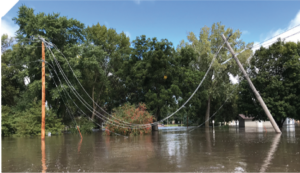Rapid Response to Natural Disasters: Ensuring Public Safety and Infrastructure Recovery
By Josh Pope

Athletes don’t show up to a championship match without practicing, actors don’t take the Broadway stage without having rehearsals, and diplomats don’t enter a negotiation with the intent to “wing it.” No matter the industry, high-performing professionals spend time planning, practicing, and refining their approach. They assess what works — and what doesn’t — and adjust their strategy and repeat the process until they are fully prepared to succeed and shine when it matters the most.
When it comes to natural disasters, we can never predict when they will occur or how severe they will be. However, we know it’s only a matter of time before one occurs. As city leaders, we can’t simply stand by and hope for the best or rely on another entity to handle disaster response for us. Like athletes, actors, and diplomats, we must prepare.
The critical role of local response

We have all likely witnessed — and some of us have experienced — the disruption caused by natural disasters. The initial local response is crucial in shaping the outcome of these events. When disaster strikes, attention focuses on the imminent threat, making it difficult to anticipate long-term risks in the moment. However, failing to make rational and informed decisions can impact our interconnected infrastructure systems during the disaster and throughout the recovery process. That’s why city teams must prepare in advance, ensuring they can respond deliberately, effectively, and quickly under stressful conditions.
Leveraging institutional knowledge
City teams understand the intricacies of their infrastructure systems better than anyone else. They know which streets will flood first, when lift stations become overwhelmed, and which properties are at risk from sewer backups or water supply disruptions. This institutional knowledge is critical for effective disaster response and recovery. However, if it is siloed within individual departments, the city may miss opportunities for a more comprehensive and coordinated response.
To maximize a successful response, a city should build upon this institutional knowledge and continually identify potential failure scenarios. By running through hypothetical disaster situations, the city and consultant teams can:
- Determine at-risk infrastructure components.
- Identify necessary materials and equipment for a response.
- Establish key contacts from other city departments and external agencies.
- Decide when to escalate issues and who to call.
- Plan the sequence of response operations to maximize effectiveness.
Adjusting disaster response plans
Establishing a sequence of response actions positions a city to react effectively when unexpected challenges arise. For example, a sewer collection department recently responded to backup threats to homes caused by rising floodwaters entering the sewer collection system. Based on decades of operational experience, the department enacted their relief plan at a designated manhole. However, despite their efforts, they struggled to safeguard homes — even after surface flooding receded.
The team asked themselves, “How can we do this better? Our team has been rotating between this and other threatened areas for days and we need a more effective approach.”
Upon evaluation, they discovered that while the relief manhole had been effective when the system was smaller, it had become less effective due to decades of system growth and reconfiguration. After this realization, the department shifted to a more optimal relief location, which significantly reduced their operational efforts while better protecting the overall system. This adjustment also helped reopen local roads and reduced the need for dedicated monitoring of critical water supply facilities.
By asking a simple question, the department is now better positioned to safeguard more properties with less effort the next time a flood occurs in this area. But they aren’t stopping there — after seeing the benefits of this adjustment, they are working with consultants to evaluate the entire response plan for broader improvements across the sewer utility and other infrastructure systems.
Preparedness leads to success
This is just one scenario of how planning, practicing, and refining response strategies can lead to better disaster outcomes. Across cities, countless other examples show that well-prepared teams respond more effectively when disaster strikes.
Just as athletes, actors, and diplomats are honored for their performances, city teams that prepare for disaster response will be recognized as champions of infrastructure systems — shining when their communities need them the most.
Josh Pope is a principal engineer at Bolton & Menk (bolton-menk.com). Bolton & Menk is a member of the League’s Business Leadership Council (lmc.org/sponsors).

